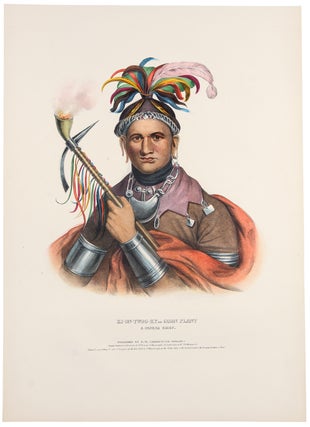MCKENNEY, Thomas L. (1785-1859) and James HALL (1793-1868)
Ki-On-Twog-Ky, or Cornplant
Philadelphia: F. W. Greenough, 1838. Hand-coloured lithograph by J. T. Bowen after a painting by Charles Bird King. In excellent condition. Sheet size: 20 3/16 x 14 1/2 inches.
A fine image from McKenney and Hall's 'Indian Tribes of North America': `One of the most important [works] ever published on the American Indians' (Field),` a landmark in American culture' (Horan) and an invaluable contemporary record of a vanished way of life.
The son of a Seneca mother and the Dutch(or possibly Irish) trader John Abeel or O'Bail, Kiontwogky (now Kaintwakon) or Cornplanter was one of three principal leaders of the Iroquois Confederacy of Six Nations and a renowned Seneca war chief who fought in the French and Indian War (1754-1763). In opposition to Joseph Brant's insistence that the Confederacy ally itself with the British in the American Revolution, Cornplanter, like Red Jacket, favored neutrality, claiming that the war was a white man's affair in which they shouldn't intervene. Despite his initial protestations and the uncustomary dissension among the members of the Grand Council regarding the issue of participating in the war, the Seneca eventually yielded to majority opinion and agreed to fight for the British. At the end of the war, after several victories and a serious defeat, Cornplanter became a diplomatic mediator between the Seneca and the whites, negotiating auspicious terms for his nation. He was on friendly terms with George Washington, who tried to use him as a diplomatic representative to troublesome tribes in Ohio. (His people refused to let him go). As time went on he became increasingly unpopular among the Seneca after signing treaties at Fort Stanwix (1784), Fort Harmar (1789), and Genesee (1797), which ceded tracts of their ancestral homelands to the Federal government, becoming New York State. Although his conciliatory actions earned him the contempt of his nation and political rivals such as Red Jacket, he obtained the appreciation of the U.S. government, which, in return for his cooperation in the Genesee treaty, awarded him an annual pension and a plot of land in Pennsylvania. In 1786, he traveled to Philadelphia to attend a ceremony given by the Tammany Society, an organization devoted to synthesizing European and Native American culture, and then went to New York to meet with Congress regarding the distribution of Iroquois lands. Cornplanter later journeyed to Washington to visit President Jefferson in 1801-2, and, later, despite his depleted authority, rallied the Seneca to the American cause in the War of 1812. McKenney and Hall's 'Indian Tribes of North America' has long been renowned for its faithful portraits of Native Americans. The portraits are largely based on paintings by the artist Charles Bird King, who was employed by the War Department to paint the Indian delegates visiting Washington D.C., forming the basis of the War Department's Indian Gallery. Most of King's original paintings were subsequently destroyed in a fire at the Smithsonian, and their appearance in McKenney and Hall's magnificent work is thus our only record of the likenesses of many of the most prominent Indian leaders of the nineteenth century. Numbered among King's sitters were Sequoyah, Red Jacket, Major Ridge, Keokuk, and Black Hawk. After six years as Superintendent of Indian Trade, Thomas McKenney had become concerned for the survival of the Western tribes. He had observed unscrupulous individuals taking advantage of the Native Americans for profit, and his vocal warnings about their future prompted his appointment by President Monroe to the Office of Indian Affairs. As first director, McKenney was to improve the administration of Indian programs in various government offices. His first trip was during the summer of 1826 to the Lake Superior area for a treaty with the Chippewa, opening mineral rights on their land. In 1827, he journeyed west again for a treaty with the Chippewa, Menominee , and Winebago in the present state of Michigan. His journeys provided an unparalleled opportunity to become acquainted with Native American tribes. When President Jackson dismissed him from his government post in 1830, McKenney was able to turn more of his attention to his publishing project. Within a few years, he was joined by James Hall, a lawyer who had written extensively about the west. McKenney and Hall saw their work as a way of preserving an accurate visual record of a rapidly disappearing culture. (Gilreath).
Cf. Howes M129; cf. Bennett 79; cf. Field 992; cf. Lipperheide Mc 4; cf. Reese American Color Plate Books 24; cf. Sabin 43410a.
Item #28142
Price: $1,200.00

.jpg?width=768&height=1000&fit=bounds&auto=webp&v=1637266621)

